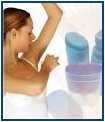Underarm antiperspirants may contribute to the risk of breast cancer because they contain aluminum salts with metal ions that mimic the effect of estrogen.
BackgroundClinical studies showing a disproportionately high incidence of breast cancer in the upper outer quadrant of the breast together with reports of genomic instability in outer quadrants of the breast provide supporting evidence for a role for locally applied cosmetic chemicals in the development of breast cancer. Aluminium salts are used as the active antiperspirant agent in underarm cosmetics, but the effects of widespread, long term and increasing use remain unknown, especially in relation to the breast, which is a local area of application. Aluminium is known to have a genotoxic profile, capable of causing both DNA alterations and epigenetic effects, and this would be consistent with a potential role in breast cancer if such effects occurred in breast cells.
XenoestrogensOver recent years scientists have found that many compounds in the environment mimic or interfere with oestrogen. The widespread origin and diversity in chemical structure of these environmental oestrogens is extensive but to date such compounds have been organic and in particular phenolic or carbon ring structures of varying structural complexity. These compounds are found in many plants, and used in materials like detergents, pesticides and plastics. Now scientists are realising that environmental oestrogens can also be inorganic and such xenoestrogens have been termed metalloestrogens. There is mounting evidence that simpple metal ions, including aluminium, antimony, arsenite, barium, cadmium, chromium (Cr(II)), cobalt, copper, lead, mercury, nickel, selenite, tin and vanadate have to be added to the list of such metalloestrogens.
 Link between aluminum and cancer ?
Link between aluminum and cancer ?"Since oestrogen is known to be involved in the development and progression of human breast cancer, any components of the environment that have oestrogenic activity and which can enter the human breast could theoretically influence a woman's risk of breast cancer," says author of the review Dr Philippa Darbre, who works in the School of Biological Sciences, at the University of Reading, UK.
Aluminium salts in antiperspirants are a major source of exposure to aluminium in humans. It is often sprayed into armpits, inadvertently concentrating exposure near to the breast. In addition, it is often applied immediately after shaving, when the skin is likely to be damaged and less able to keep the aluminium out. "It is reasonable to question whether this aluminium could then influence breast cancer," says Darbre.
Her concern is not confined to aluminium. Smoking tobacco introduces cadmium into the body, and research shows that it too can collect in breast tissue. There are indications that this accumulation of cadmium may also be linked to an increased risk of breast cancer, potentially showing one of the reasons why smoking could be linked to this disease.
"Each of these agents on their own may not have a powerful effect, but we need to see what happens when a number of them act together – it could be that this would have a significant effect on diseases like breast cancer," says Darbre.
 The original study
The original study

P.D. Darbre,
Metalloestrogens:
An Emerging Class of Inorganic Xenoestrogens with Potential to Add to
the Oestrogenic Burden of the Human Breast, J. Appl. Toxicol., 26 (2006) 191-197.
DOI:10.1002/jat.1135  Related studies
Related studies (newest first)

Philippa D. Darbre, Ferdinando Mannello, Christopher Exley,
Aluminium and breast cancer: Sources of exposure, tissue measurements and mechanisms of toxicological actions on breast biology, J. Inorg. Biochem., 128 (2013) 257–261.
DOI: 10.1016/j.jinorgbio.2013.07.005
P.D. Darbre, D. Pugazhendhi, F. Mannello,
Aluminium and human breast diseases, J. Inorg. Biochem., 105 (2011) 1484–1488.
DOI: 10.1016/j.jinorgbio.2011.07.017
M. Namer, E. Luporsi, J. Gligorov, F. Lokiec, M. Spielmann,
The use of
deodorants/antiperspirants does not constitute a risk factor for breast
cancer, Bull Cancer, 95/9 (2008)871-880.
DOI : 10.1684/bdc.2008.0679
C. Exley, L.M. Charles, L. Barr, C. Martin, A. Polwart, P.D. Darbre,
Aluminium in human breast tissue, J. Inorg. Biochem., 101/9 (2007) 1344-1346.
DOI: 10.1016/j.jinorgbio.2007.06.005
P.D. Darbre,
Aluminium, antiperspirants and breast cancer, J. Inorg. Biochem., 99/9 (2005) 1912-1919.
DOI: 10.1016/j.jinorgbio.2005.06.001
P.D. Darbre,
Underarm cosmetics and breast cancer, J. Appl. Toxicol., 23/2 (2003) 89-95.
DOI: 10.1002/jat.899
Dana K. Mirick, Scott Davis, David B. Thomas,
Antiperspirant Use and the Risk of Breast Cancer, J. Natl. Cancer Inst., 94/20 (2002) 578-1580.
DOI: 10.1093/jnci/94.20.1578  Related EVISA Resources
Related EVISA Resources
 Link database: Toxicity of aluminium species
Link database: Toxicity of aluminium species Related Information
Related Information
 www.deoohnealuminium.de: Deodorants without aluminium (in German)
www.deoohnealuminium.de: Deodorants without aluminium (in German)  BfR: Aluminiumhaltige Antitranspirantien tragen zur Aufnahme von Aluminium bei (in German)
BfR: Aluminiumhaltige Antitranspirantien tragen zur Aufnahme von Aluminium bei (in German)  US National Cancer Institute: Antiperspirants/Deodorants and Breast Cancer
US National Cancer Institute: Antiperspirants/Deodorants and Breast Cancer  American Cancer Society: Antiperspirants and Breast Cancer Risk
American Cancer Society: Antiperspirants and Breast Cancer Risklast time modified: March 6, 2024